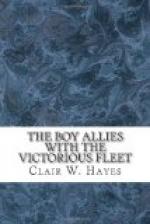“Oh, we’ll be back, never fear,” grinned Jack. “But what are we to do now?”
“You will report to Admiral Keyes aboard the Warwick at once. If you return safely, report to me. Good-bye and good luck.”
The lads shook hands with Lord Hastings and left him.
“Here,” said Frank, “is what I call a piece of luck.”
CHAPTER VII
A BIT OF EXPLANATION
It is probable that the sealing of the harbors of Ostend and Zeebrugge, two of the most important German submarine bases, was one of the greatest feats of the whole European war. The attempt was extremely hazardous and could never have been successful except for the gallantry and heroism of the British crews.
Not the least of the bravest among them were Jack and Frank and the other officers and crew of the destroyer Brigadier. It is true that the operation has been planned primarily with the idea of having the destroyer Daffodil in line, but it was the withdrawal of this vessel that permitted Jack and Frank to have a hand in the operation.
In order that all parts of the naval service might share in the expedition, representative bodies of men had been drawn from the Grand Fleet, the three home depots, the Royal marine artillery and light infantry. The ships and torpedo craft were furnished by the Dover patrol, which was reinforced by vessels from the Harwich force and the French and American navies. The Royal Australian navy and the admiralty experimental station at Stratford and Dover were also represented.
A force thus composed and armed, obviously needed collective training and special preparation to adapt both the men and their weapons to their purpose. With these objects, the blocking ships and the storming forces were assembled toward the end of February, and from the fourth of April on in the West Swim Anchorage—where training especially adapted to the plan of operation was given—and the organization of the expedition was carried on.
The material as it was prepared was used to make the training practical and was itself tested thereby. Moreover, valuable practice was afforded by endeavors to carry out the project on two previous occasions, on which the conditions of wind and weather compelled its postponement, and much was learned from these temporary failures.
The Hindustan, at first at Chatham and later at the Swim, was the parent ship and training depot. After the second attempt, when it became apparent that there would be a long delay, the Dominion joined the Hindustan and the pressure upon the available accommodation was relieved by the transfer of about 350 seamen and marines to her.
Two special craft, Liverpool ferry steamers, Iris and Gloucester, were selected after a long search by Captain Herbert Grant. They were selected because of their shallow draft, with a view in the first place to their pushing the Vindictive, which was to bear the brunt of the work, alongside Zeebrugge Mole; to the possibility, should the Vindictive be sunk, of their bringing away all her crew and the landing parties; and to their ability to maneuver in shallow water or clear of mine fields or torpedoes. The blocking ships and the Vindictive were especially prepared for their work long before the start.




